In this article we shall learn about the light bulb types which are commonly used in the world. The electric lamps commonly used are incandescent lamps that were invented by Thomas Alva Edison and Joseph Swan in nineteenth century.
Humphrey Davy created the first light using an arc lamp. The arc lamp took too much power for use in residential houses. Edison bought the idea of the light bulb from inventors and patented it.
Humphrey Davy connected wires to a battery and a piece of charcoal, which made an intense spark. This became known as the electric arc lamp. Thomas Edison then used a filament housed in a glass vacuum bulb. He then passed electricity through this which lit the bulb.
Although, now a days use of light emitting diodes LEDs is increasing for lighting and indication etc. but still conventional lamps are dominating in uses. While selecting the light bulbs for a purpose we must consider power rating and current rating of the electric lamp.
Below is list and details about different types of electric lamps / light bulbs.
Incandescent lamp
Fluorescent lamp
Compact fluorescent lamp
High-Intensity Discharge lamp
Low-pressure Sodium lamp
High-pressure Sodium lamp
Light Emitting Diodes(LED)
Incandescent Lamp
This type of light bulb produces heat and brightness with the help of filament of Tungsten metal.
When current is passing through this filament, it produces light.
The hot filament is protected from oxidation with glass which is filled with gas.
The life of this type of lamp spans around 700 to 1000 hours and the temperature reaches at about 2200°C.
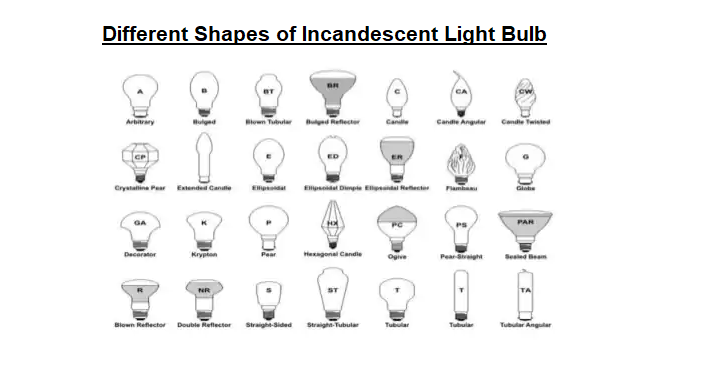
Incandescent lamp or incandescent light globe is an electric light which produces light with a filament wire heated to a high temperature by an electric current passing through it, until it glows.
The hot filament is protected from oxidation with a glass or quartz bulb that is filled with inert gas or evacuated.
In a halogen lamp, filament evaporation is prevented by a chemical process that redeposit metal vapour onto the filament, extending its life.
The light bulb is supplied with electrical current by feed-through terminals or wires embedded in the glass.
Most bulbs are used in a socket which provides mechanical support and electrical connections .
Halogen Lamps
A halogen lamp, also known as a tungsten halogen, quartz-halogen or quartz iodine lamp, is an incandescent lamp that has a small amount of a halogen such as iodine or bromine added.
The combination of the halogen gas and the tungsten filament produces a halogen cycle chemical reaction which redeposit evaporated tungsten back onto the filament, increasing its life and maintaining the clarity of the envelope.
Because of this, a halogen lamp can be operated at a higher temperature than a standard gas-filled lamp of similar power and operating life, producing light of a higher luminous efficacy and color temperature.
Halogen lamps are high intensity light bulbs which are long life, also called tungsten halogen or quartz halogen bulbs.
These lamps are filled with a halogen gas, usually Krypton.
Halogen bulbs are much brighter as compared to the incandescent light lamps, and are much more energy efficient for the intensity of light produced i.e. lumens.
Halogen lamps are used as part of the headlights in many automobiles.
The life span of halogen light bulb is two or three times more than Incandescent lamps.
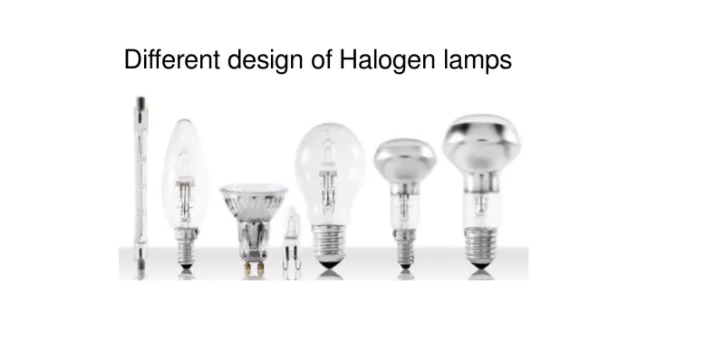 Fluorescent Light Lamps
Fluorescent Light Lamps
The most common application of this technology is in tubular fluorescent lamps.
Fluorescent bulbs are filled with argon gas and when electricity is passed through, a small amount of mercury in the tube produces ultraviolet radiation which in turn causes the phosphorous coating of the tube to give off the light.
Main benefit of a fluorescent bulb is its long life.
Fluorescent bulbs are very efficient and produce very little negligible heat.
The life of this type of bulbs spans between 10000 and 20000 hours.
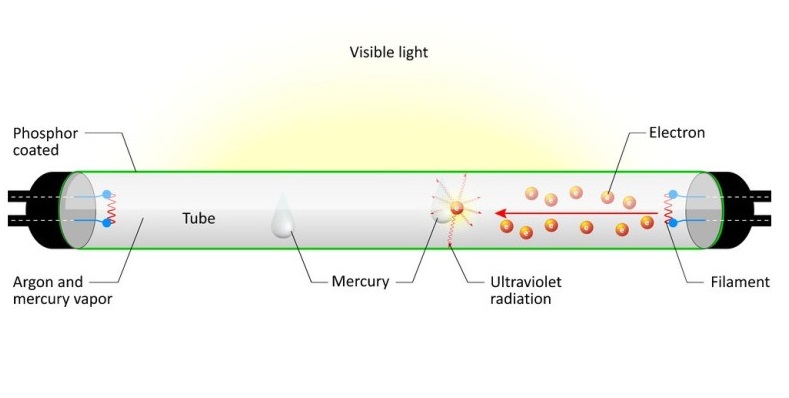
Compact Fluorescent Lamps
A compact fluorescent lamp (CFL), also called compact fluorescent light, energy-saving light, and compact fluorescent tube, is a fluorescent lamp designed to replace an incandescent lamp; some types fit into light fixtures formerly used for incandescent lamps.
The lamps use a tube which is curved or folded to fit into the space of an incandescent bulb, and a compact electronic ballast in the base of the lamp.
Compared to general-service incandescent lamps giving the same amount of visible light, CFLs use one-fifth to one-third the electric power, and last eight to fifteen times longer.
A CFL has a higher purchase price than an incandescent lamp, but can save over five times its purchase price in electricity costs over the lamp’s lifetime
A Compact Fluorescent Lamp (CFL) has the characteristics and advantages of linear fluorescent lamps but its compact size is achieved by folding the discharge path, retaining high efficacy.
A 20-25 watt CFL is approximately equivalent to a 100 watt incandescent bulb.
Working principle of compact fluorescent bulb is same as fluorescent lamps.
Life spans up to 10000 hours.
High-Intensity Discharge Lamps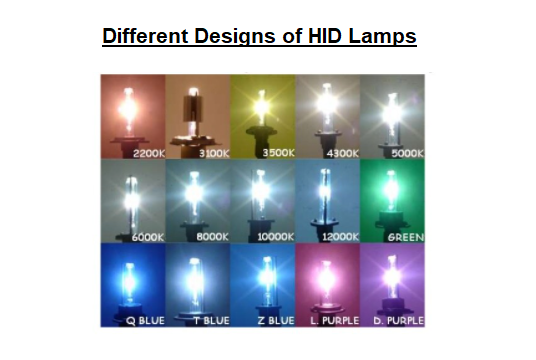
The inner tube is filled with various metals and when the metals heat to the point of evaporation, the bulb produces light.
At high pressure, the mercury discharge is mainly blue and green radiation.
HID lamps are used to light sports fields, parking lots and roadways.
All high-pressure mercury lamps take time to reach full output.
Life of HID lamps is around 20000 hours.
Sodium Vapor Lamps
A sodium vapour lamp is a gas-discharge lamp that uses sodium in an excited state to produce light.
There are two varieties of such lamps: low pressure and high pressure.
Low- pressure sodium lamps are the most efficient electrical light sources, but their yellow light restricts applications to outdoor lighting such as street lamps.
High-pressure sodium lamps have a broader spectrum of light than the low pressure, but still poorer color rendering than other types of lamps.
Low pressure sodium lamps only give monochromatic yellow light and so inhibit color vision at night.
Low-pressure Sodium Light Bulb / Lamp
LPS lamps produce light through a very similar process as a fluorescent bulb.
This type of electric bulb emits yellow light and requires a ballast like a fluorescent bulb.
LPS lamps are used when the highest efficiency light is needed.
Most LPS lamps are used for driveways, parking lots and pathways.
High-pressure Sodium Lamp
High-pressure sodium (HPS) lamps are smaller and contain additional elements such as mercury.
It produces a dark pink glow when first struck, and an intense pinkish orange light when warmed.
As the sodium pressure is increased, the radiation becomes a broad band around the yellow peak, and the appearance is pinkish orange.
LED Bulbs – Light Emitting Diodes
An LED lamp is a light-emitting diode (LED) product that is assembled into a lamp (or light bulb) for use in lighting fixtures.
LED lamps have a lifespan and electrical efficiency that is several times better than incandescent lamps, and significantly better than most fluorescent lamps, with some chips able to emit more than 100 lumens per watt.
Like incandescent lamps and unlike most fluorescent lamps (e.g. tubes and CFL), LED lights come to full brightness without need for a warm-up time; the life of fluorescent lighting is also reduced by frequent switching on and off.
Initial cost of LED is usually higher.
This kind of bulbs do not have a filament and can give different lights.
LED bulbs consume the least amount of electricity and produce the least amount of heat.
The LED bulbs have a very long life.
LED bulbs can come in a wide variety of colors and can be used when colored accent lighting is needed.
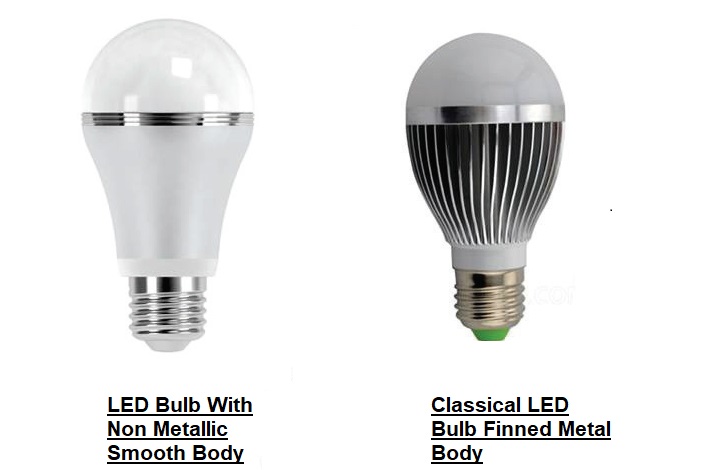
Neon Glow Bulb / Lamp
A neon lamp (also neon glow lamp) is a miniature gas discharge lamp that typically contains neon gas at a low pressure in a glass capsule.
Only a thin region adjacent to the electrodes glows in these lamps, which distinguishes them from the much longer and brighter neon tubes used for signage.
The term “neon lamp” is generally extended to lamps with similar design that operate with different gases.
Neon glow lamps were very common in the displays of electronic instruments through the 1970s; the basic design of neon lamps is now incorporated in contemporary plasma displays.
Neon was discovered in 1898 by William Ramsay and Morris W. Travers.
The characteristic, brilliant red color that is emitted by gaseous neon when excited electrically was noted immediately; Travers later wrote, “the blaze of crimson light from the tube told its own story and was a sight to dwell upon and never forget.”
Neon’s scarcity precluded its prompt application for electrical lighting along the lines of Moore tubes, which used electric discharges in nitrogen.
Moore tubes were commercialized by their inventor, Daniel McFarlane Moore, in the early 1900s.
After 1902, Georges Claude’s company, Air Liquid, was producing industrial quantities of neon as a by product of his air liquefaction business, and in December. Neon lamp
Mercury Lamps / Bulbs
A mercury vapour lamp is a gas discharge lamp that uses an electric arc through vaporized mercury to produce light.
The arc discharge is generally confined to a small fused quartz arc tube mounted within a larger borosilicate glass bulb.
The outer bulb may be clear or coated with a phosphor; in either case, the outer bulb provides thermal insulation, protection from the ultraviolet radiation the light produces, and a convenient mounting for the fused quartz arc tube.
List of Artificial Light Sources
- Incandescent Lamps
- Fluorescent Lamps
- High – Intensity Discharge Lamps
- Mercury Lamps
- Metal Halide Lamps
- High Pressure Sodium Lamps
- Low Pressure Sodium Lamps
- Electrodeless Lamps
- Compact arc xenon &Mercury Lamps
- Electroluminescent Lamps
- Light Emitting Diodes (LED)
- Carbon arc Lamps
- Gaslights
Discover more from Electrical Engineering 123
Subscribe to get the latest posts sent to your email.
